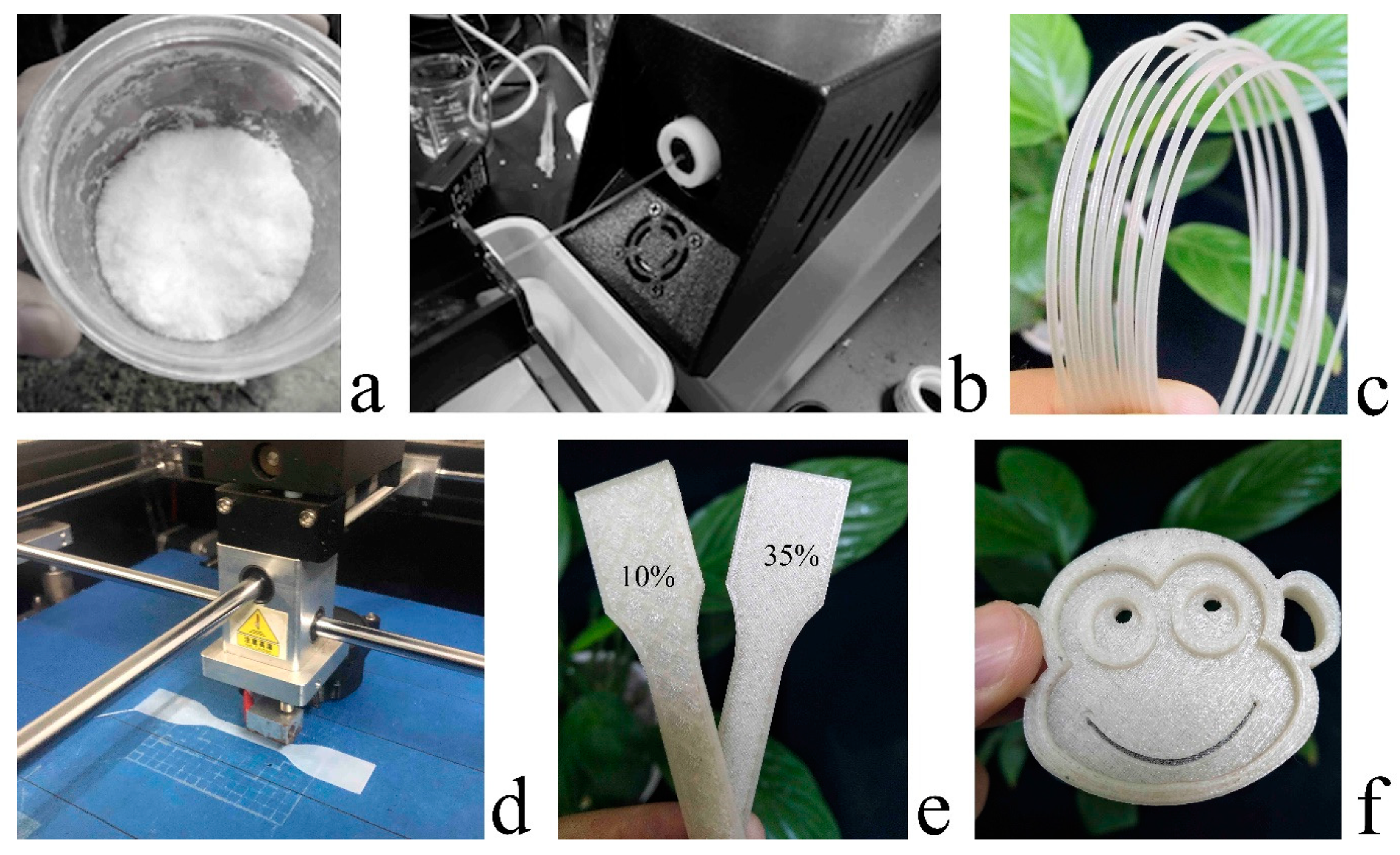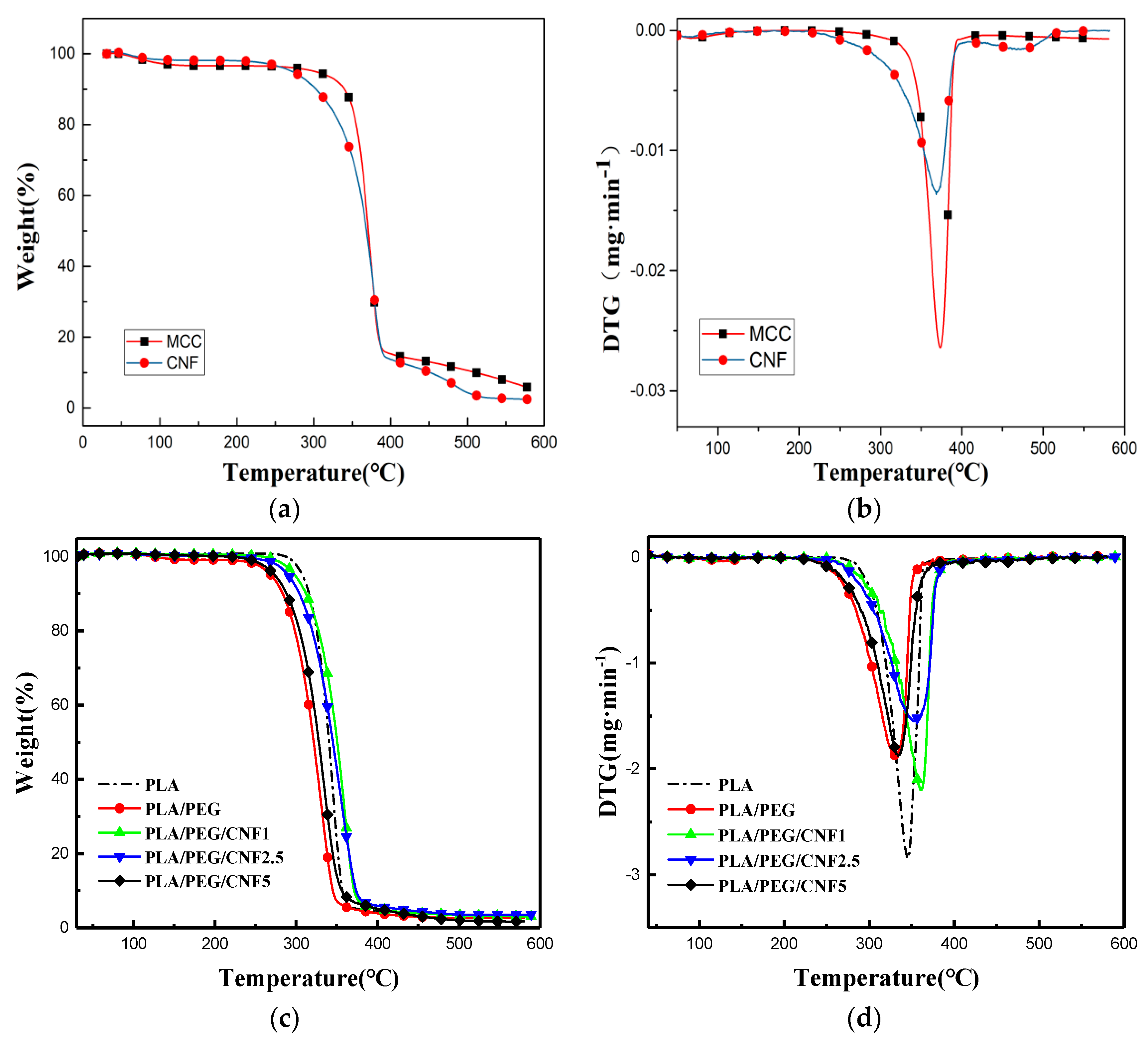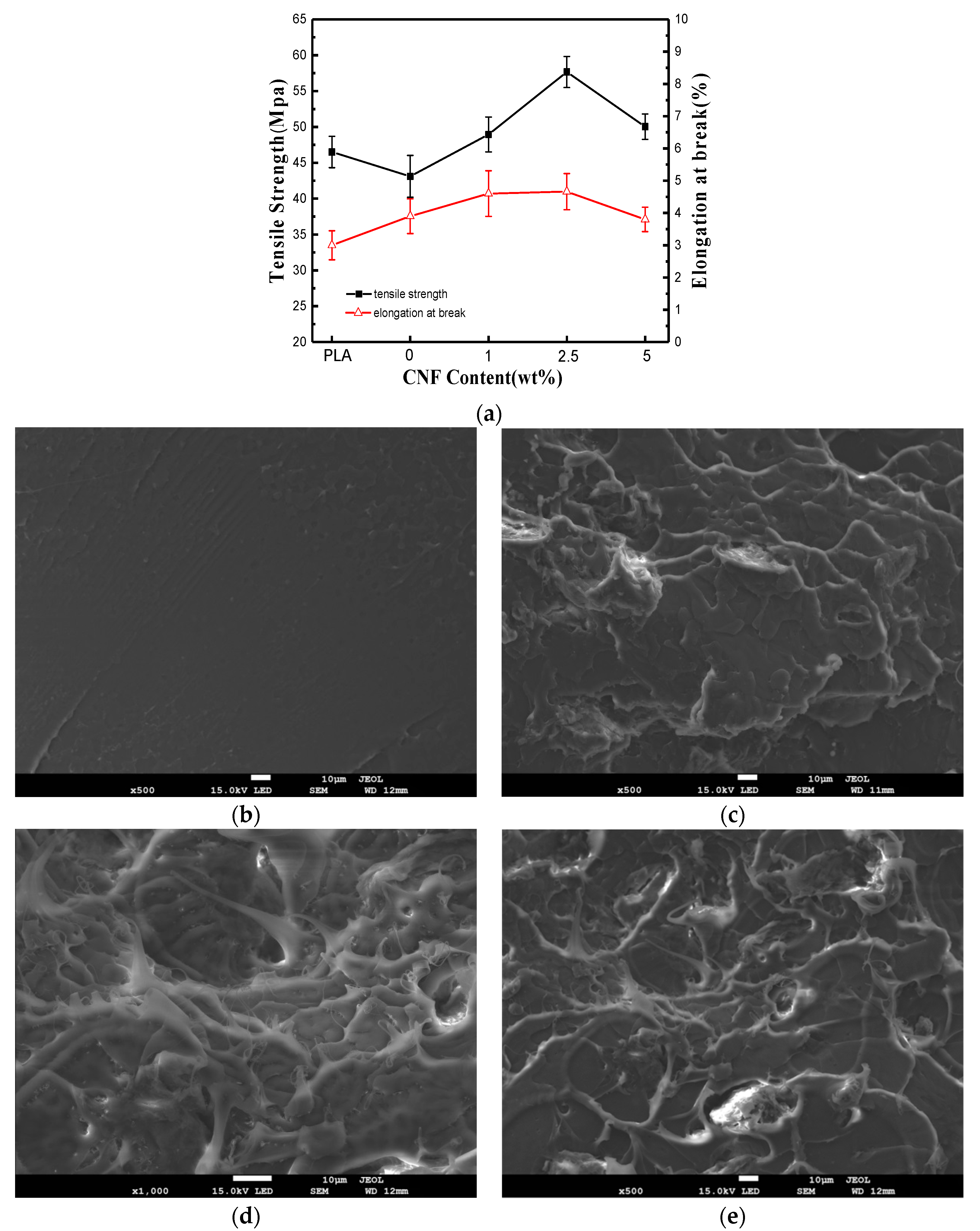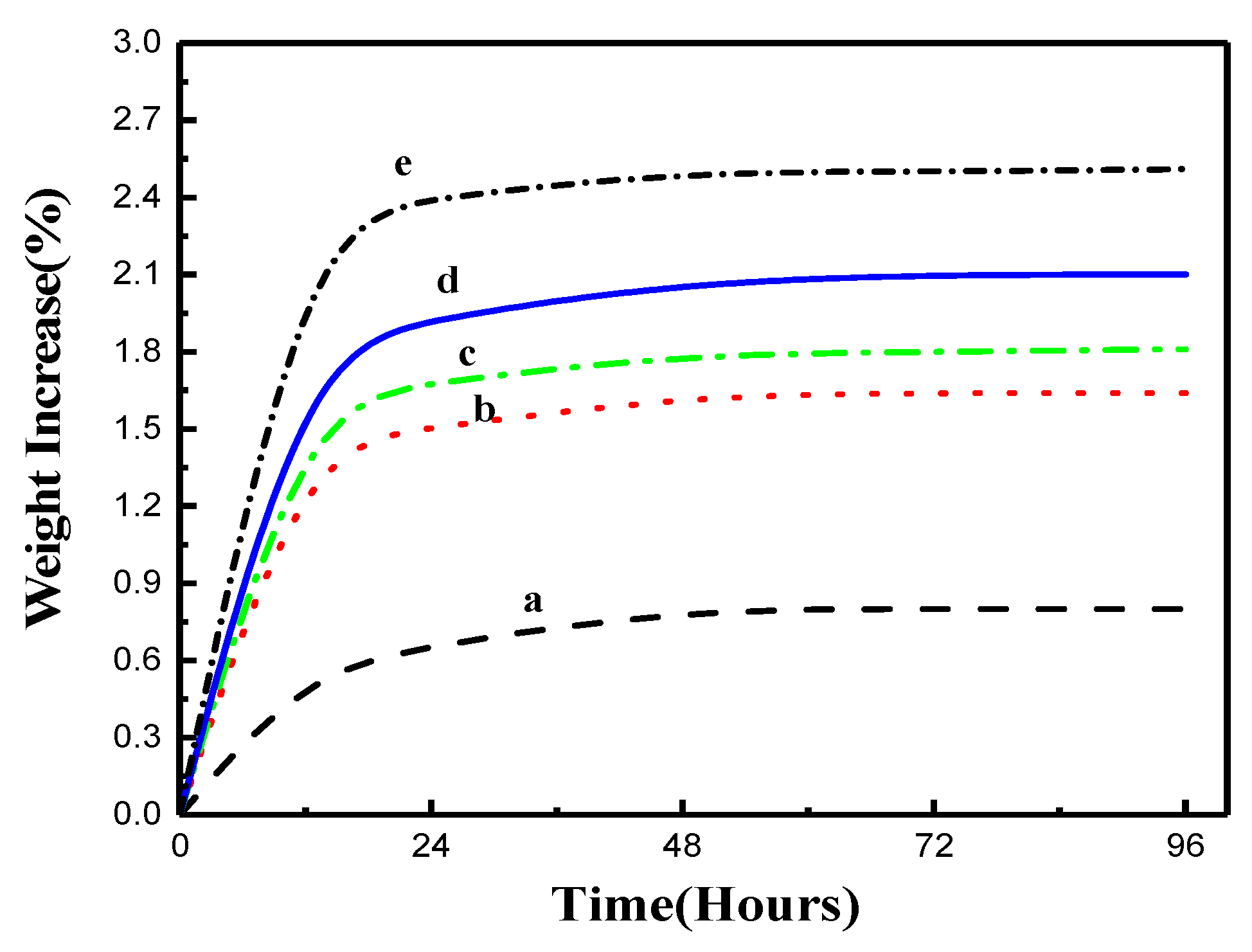Cellulose Nanofibrils Filled Poly(Lactic Acid) Biocomposite Filament for FDM 3D Printing
Abstract
1. Introduction
2. Results
2.1. CNF Morphological Observation
2.2. PLA/CNF Thermal Stability Analysis
2.3. PLA/PEG600/CNF Composites Mechanical Performance Analysis
2.4. PLA/PEG600/CNF Composites Water Absorption
3. Discussion
3.1. Filament Extrusion and 3D Printing
3.2. Preparation CNF and PLA/PEG600/CNF Composites
3.3. Textile and Apparel Product Applications
4. Material and Methods
4.1. CNF Isolation
4.2. PLA/CNF Composite Development and Testing
4.2.1. Preparing the PLA/CNF Composite
4.2.2. Thermal Stability
4.2.3. Mechanical Performance
4.2.4. Water Absorption
4.2.5. 3D Printing and Evaluation
5. Conclusions
Author Contributions
Funding
Conflicts of Interest
References
- Wang, Q.Q.; Sun, J.Z.; Yao, Q.; Ji, C.C.; Liu, J.; Zhu, Q.Q. 3D printing with cellulose materials. Cellulose 2018, 25, 4275–4301. [Google Scholar] [CrossRef]
- Liu, J.; Sun, L.; Xu, W.; Wang, Q.; Yu, S.; Sun, J. Current advances and future perspectives of 3D printing natural-derived biopolymers. Carbohydr. Polym. 2019, 207, 297–316. [Google Scholar] [CrossRef] [PubMed]
- Wong, K.V.; Hernandez, A. A review of additive manufacturing. Int. Sch. Res. Not. 2012, 2012, 208760. [Google Scholar] [CrossRef]
- Horn, T.J.; Harrysson, O.L. Overview of current additive manufacturing technologies and selected applications. Sci. Prog. 2012, 95, 255–282. [Google Scholar] [CrossRef] [PubMed]
- Bose, S.; Vahabzadeh, S.; Bandyopadhyay, A. Bone tissue engineering using 3D printing. Mater. Today 2013, 16, 496–504. [Google Scholar] [CrossRef]
- Sun, L.; Zhao, L. Envisioning the era of 3D printing: A conceptual model for the fashion industry. Fash. Text. 2017, 4, 25. [Google Scholar] [CrossRef]
- Robinson, F. Chanel’s Couture Progression: 3D Printing Materiality. Available online: http://www.disrup-tivemagazine.com/opinion/chanel%E2%80%99s-couture-progression-3d-printing-materiality (accessed on 1 April 2018).
- Danit, P. How I 3D Printed a 5 Piece Fashion Collection at Home. Available online: http://danitpeleg.com/3d-printing-fashion-process/ (accessed on 1 April 2018).
- Melnikova, R.; Ehrmann, A.; Finsterbusch, K. IOP Conference Series: Materials Science and Engineering, Proceedings of the 3D Printing of Textile-Based Structures by Fused Deposition Modelling (FDM) with Different Polymer Materials, Ningbo, China, 27–29 May 2014; IOP Publishing: Bristol, UK, 2014; p. 012018. [Google Scholar]
- Lussenburg, K.; Van Der Velden, N.; Doubrovski, Z.; Karana, E. Designing (with) 3D Printed Textiles. Master’s Thesis, Delft University of Technology, Delft, The Netherlands, 2014. [Google Scholar]
- Tanney, D.; Meisel, N.A.; Moore, J. Investigating Material Degradation through the Recycling of PLA in Additively Manufactured Parts. In Proceedings of the 28th Annual International Solid Freeform Fabrication Symposium, Austin, TX, USA, 7–9 August 2017; pp. 519–531. [Google Scholar]
- Lanzotti, A.; Martorelli, M.; Maietta, S.; Gerbino, S.; Penta, F.; Gloria, A. A comparison between mechanical properties of specimens 3D printed with virgin and recycled PLA. Procedia Cirp 2019, 79, 143–146. [Google Scholar] [CrossRef]
- Anderson, I. Mechanical properties of specimens 3D printed with virgin and recycled polylactic acid. 3d Print. Addit. Manuf. 2017, 4, 110–115. [Google Scholar] [CrossRef]
- Murphy, C.A.; Collins, M.N. Microcrystalline cellulose reinforced polylactic acid biocomposite filaments for 3D printing. Polym. Compos. 2018, 39, 1311–1320. [Google Scholar] [CrossRef]
- Mathew, A.P.; Oksman, K.; Sain, M. Mechanical properties of biodegradable composites from poly lactic acid (PLA) and microcrystalline cellulose (MCC). J. Appl. Polym. Sci. 2005, 97, 2014–2025. [Google Scholar] [CrossRef]
- Lendvai, L.; Karger-Kocsis, J.; Kmetty, Á.; Drakopoulos, S.X. Production and characterization of microfibrillated cellulose-reinforced thermoplastic starch composites. J. Appl. Polym. Sci. 2016, 133, 42397. [Google Scholar] [CrossRef]
- Suryanegara, L.; Nakagaito, A.N.; Yano, H. The effect of crystallization of PLA on the thermal and mechanical properties of microfibrillated cellulose-reinforced PLA composites. Compos. Sci. Technol. 2009, 69, 1187–1192. [Google Scholar] [CrossRef]
- Campbell, T.A.; Ivanova, O.S. 3D printing of multifunctional nanocomposites. Nano Today 2013, 8, 119–120. [Google Scholar] [CrossRef]
- Wang, Z.; Xu, J.; Lu, Y.; Hu, L.; Fan, Y.; Ma, J.; Zhou, X. Preparation of 3D printable micro/nanocellulose-polylactic acid (MNC/PLA) composite wire rods with high MNC constitution. Ind. Crop. Prod. 2017, 109, 889–896. [Google Scholar] [CrossRef]
- Wang, Q.; Wei, W.; Chang, F.; Sun, J.; Xie, S.; Zhu, Q. Controlling the Size and Film Strength of Individualized Cellulose Nanofibrils Prepared by Combined Enzymatic Pretreatment and High Pressure Microfluidization. BioResources 2016, 11, 2536–2547. [Google Scholar] [CrossRef][Green Version]
- Wang, Q.; Zhao, X.; Zhu, J.Y. Kinetics of Strong Acid Hydrolysis of a Bleached Kraft Pulp for Producing Cellulose Nanocrystals (CNCs). Ind. Eng. Chem. Res. 2014, 53, 11007–11014. [Google Scholar] [CrossRef]
- Wang, Q.Q.; Zhu, J.Y.; Gleisner, R.; Kuster, T.A.; Baxa, U.; McNeil, S.E. Morphological development of cellulose fibrils of a bleached eucalyptus pulp by mechanical fibrillation. Cellulose 2012, 19, 1631–1643. [Google Scholar] [CrossRef]
- Roman, M.; Winter, W.T. Effect of sulfate groups from sulfuric acid hydrolysis on the thermal degradation behavior of bacterial cellulose. Biomacromolecules 2004, 5, 1671–1677. [Google Scholar] [CrossRef]
- Mokhena, T.; Sefadi, J.; Sadiku, E.; John, M.; Mochane, M.; Mtibe, A. Thermoplastic processing of PLA/cellulose nanomaterials composites. Polymers 2018, 10, 1363. [Google Scholar] [CrossRef]
- Wang, Q.; Ji, C.; Sun, J.; Yao, Q.; Liu, J.; Saeed, R.M.Y.; Zhu, Q. Kinetic thermal behavior of nanocellulose filled polylactic acid filament for fused filament fabrication 3D printing. J. Appl. Polym. Sci. 2019, 137, 48374. [Google Scholar] [CrossRef]
- Wulandari, W.T.; Rochliadi, A.; Arcana, I.M. Nanocellulose prepared by acid hydrolysis of isolated cellulose from sugarcane bagasse. Iop Conf. Ser. Mater. Sci. Eng. 2016, 107, 012045. [Google Scholar] [CrossRef]
- Jia, S.; Yu, D.; Zhu, Y.; Wang, Z.; Chen, L.; Fu, L. Morphology, crystallization and thermal behaviors of PLA-based composites: Wonderful effects of hybrid GO/PEG via dynamic impregnating. Polymers 2017, 9, 528. [Google Scholar] [CrossRef] [PubMed]
- Tymrak, B.; Kreiger, M.; Pearce, J.M. Mechanical properties of components fabricated with open-source 3-D printers under realistic environmental conditions. Mater. Des. 2014, 58, 242–246. [Google Scholar] [CrossRef]
- Tao, Y.; Wang, H.; Li, Z.; Li, P.; Shi, S.Q. Development and Application of Wood Flour-Filled Polylactic Acid Composite Filament for 3D Printing. Materials 2017, 10, 339. [Google Scholar] [CrossRef] [PubMed]
- Song, Y.; Li, Y.; Song, W.; Yee, K.; Lee, K.-Y.; Tagarielli, V.L. Measurements of the mechanical response of unidirectional 3D-printed PLA. Mater. Des. 2017, 123, 154–164. [Google Scholar] [CrossRef]
- Ingeo™ Biopolymer 4032D Technical Data Sheet. Available online: https://www.natureworksllc.com/~/media/Technical_Resources/Technical_Data_Sheets/TechnicalDataSheet_4032D_films_pdf.pdf (accessed on 8 May 2019).
- Wenjuan, Z.; Zhihua, S. The Preparation of Nano Cellulose Whiskers/Polylactic Acid Composites. In Proceedings of the 2011 International Conference on Future Computer Science and Education, Xi’an, China, 20–21 August 2011; IEEE: Piscataway, NJ, USA, 2011; pp. 123–125. [Google Scholar]
Sample Availability: Samples of the used materials are available from the authors. |





| Specimen * | Tonset(°C) | T5%(°C) | T10%(°C) | T50%(°C) | Tvmax(°C) |
|---|---|---|---|---|---|
| MCC | 353 | 301 | 340 | 371 | 372 |
| CNF | 321 | 257 | 292 | 362 | 369 |
| PLA | 311 | 308 | 316 | 340 | 346 |
| PLA/PEG | 295 | 267 | 284 | 321 | 330 |
| PLA/PEG/CNF 1 wt.% | 320 | 298 | 312 | 350 | 361 |
| PLA/PEG/CNF 2.5 wt.% | 311 | 290 | 304 | 344 | 352 |
| PLA/PEG/CNF 5 wt.% | 302 | 273 | 288 | 328 | 335 |
© 2020 by the authors. Licensee MDPI, Basel, Switzerland. This article is an open access article distributed under the terms and conditions of the Creative Commons Attribution (CC BY) license (http://creativecommons.org/licenses/by/4.0/).
Share and Cite
Wang, Q.; Ji, C.; Sun, L.; Sun, J.; Liu, J. Cellulose Nanofibrils Filled Poly(Lactic Acid) Biocomposite Filament for FDM 3D Printing. Molecules 2020, 25, 2319. https://doi.org/10.3390/molecules25102319
Wang Q, Ji C, Sun L, Sun J, Liu J. Cellulose Nanofibrils Filled Poly(Lactic Acid) Biocomposite Filament for FDM 3D Printing. Molecules. 2020; 25(10):2319. https://doi.org/10.3390/molecules25102319
Chicago/Turabian StyleWang, Qianqian, Chencheng Ji, Lushan Sun, Jianzhong Sun, and Jun Liu. 2020. "Cellulose Nanofibrils Filled Poly(Lactic Acid) Biocomposite Filament for FDM 3D Printing" Molecules 25, no. 10: 2319. https://doi.org/10.3390/molecules25102319
APA StyleWang, Q., Ji, C., Sun, L., Sun, J., & Liu, J. (2020). Cellulose Nanofibrils Filled Poly(Lactic Acid) Biocomposite Filament for FDM 3D Printing. Molecules, 25(10), 2319. https://doi.org/10.3390/molecules25102319








